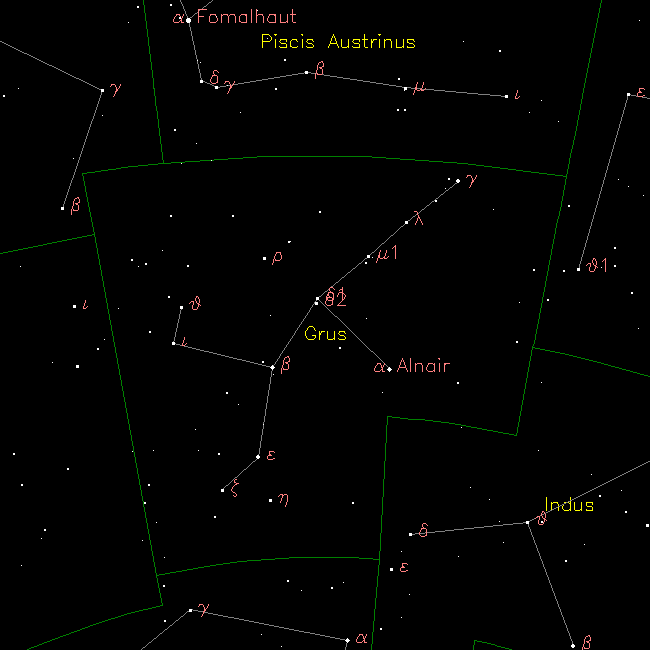[/caption]
The constellation of Grus was originally created by Petrus Plancius from the observations of Dutch sea navigators Pieter Dirkszoon Keyser and Frederick de Houtman when exploring the southern hemisphere. Grus’ stellar patterns became known when it appeared on a celestial globe in 1597 and was considered a constellation when it was added to Johann Bayer’s Uranometria catalog in 1603. It survived the years to become one of the 88 modern constellations recognized by the International Astronomical Union. Grus is located south of the ecliptic plane and covers approximately 366 square degrees of sky. It is bordered by the constellations of Piscis Austrinus, Microscopium, Indus, Tucana, Phoenix and Sculptor. The asterism consists of 7 main stars and there are 28 stars with Bayer/Flamsteed designations. Grus is visible to all observers at latitudes between +34° and ?34° and is best seen at culmination during the month of October.
Until the late 16th century, Grus was considered part of Piscis Austrinus – the “Southern Fish” – since most of its stars weren’t visible to northern latitudes. When exploration began below the equator many wondrous new creatures were discovered. One such bird was the fishing crane – Phoenicopterus – the flamingo. Perhaps this is how the constellation got is name, since Grus is also Dutch for “crane”!
First let’s take a binocular tour of Grus, starting with its brightest star, Alpha, the “a” symbol on our map. Alpha Gruis proper name is Alnair, the Arabic word for “bright one of the tail”. In this case, it was originally the tail of the fish. But besides being a bit “fishy”, Alnair is a hot, blue subgiant giant star about 101 light years away from Earth. Not only is it larger, hotter and brighter than our own Sol, but it a rather fast stellar rotation – making a complete rotation in under a day. Hop on to Beta Gruis, the “B” symbol on our map. Beta Gruis is a rare kind of star – a cooler class M giant star. It is very possible it is in an advanced state of evolution, losing mass and brightening with a dead carbon-oxygen core in preparation for sloughing its outer envelope – ready to become a Cepheid variable!
Now for visual and binocular double star, Delta 1 and Delta 2 Gruis – the “8” symbol in the center of the constellation. While this pair aren’t physically connect to one another, they do make a pleasing sight with their lovely yellow and red contrasting colors. For a true telescopic binary star, hop north to Upsilon. This disparate pair is separated by over a degree of arc and the difference between stellar magnitudes is a great experience.
For the telescope, tackle NGC 7213 (RA 22:09.3 Dec -47:10) about 16′ southeast of Alpha. This 10th magnitude Seyfert galaxy has definitely got some stories to tell. Not only is it a spiral galaxy, but one that has an incredible,giant H-alpha filament erupting from its nucleus. Another great challenge is NGC 7582, 7590 and 7599 (RA 023:19 Dec -42:3). Here is a small galaxy group consisting of three faint spirals in the same field, all tilted close to edge on. While at least an intermediate sized telescope is need to see them, a wide field eyepiece will place all three in the same field of view at around 100x magnification. Before we leave for the night, let’s try NGC 7410 (22:55.0 -39:40). This uniformly illuminated tilted spiral galaxy shows little sign of structure, despite its bright nature.

